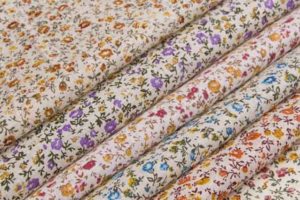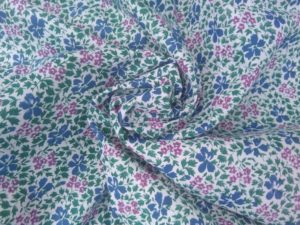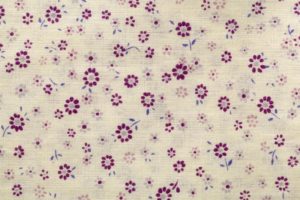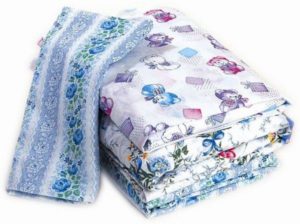When mentioning cotton fabrics, most people first of all think of chintz. Bright, elegant, thin, this fabric is the most popular of all materials made from cotton fibers.
 It is not surprising that chintz is perceived by us as the most common materials. After all, they have been using it for 9 centuries! And the familiar fabric appeared in hot India, whose inhabitants were looking for protection from the bright sun. And fabrics made from cotton fibers turned out to be the most suitable for this. They created coolness, were light, and also became a real decoration, which women especially liked.
It is not surprising that chintz is perceived by us as the most common materials. After all, they have been using it for 9 centuries! And the familiar fabric appeared in hot India, whose inhabitants were looking for protection from the bright sun. And fabrics made from cotton fibers turned out to be the most suitable for this. They created coolness, were light, and also became a real decoration, which women especially liked.
In the Middle Ages, the canvas was recognized in England, France and other European countries. Democratic calicoes were equally loved by the European aristocracy and were a real find for common people. Since the 17th century, cheerful material, as chintz is sometimes called, has firmly entered the life of Russians.
Calico fabric is formed by the simplest, alternate weaving of horizontal and vertical threads (weft and warp).As a result of this plain weaving, the material before dyeing from the wrong side looks the same as from the front.
After painting, the bright pattern becomes a distinctive feature of the front side of the canvas.
 Traditionally, natural cotton is used to make this popular material. There are no impurities in its composition.
Traditionally, natural cotton is used to make this popular material. There are no impurities in its composition.
Reference! Recently, products made from mixed fabrics, which, in addition to cotton, contain synthetic fibers, have appeared on sale. Fire (match, lighter, candle) helps to verify the naturalness of the fabric: the cotton thread burns until ash appears, the mixed fiber melts.
Currently, the production of popular cotton material is carried out in 2 stages.
At the first stage, a semi-finished fabric product is made from cotton, which experts call calico.
To make a calico, several procedures are performed successively with cotton:
 After weaving the threads into fabric (calico), the first stage of production is completed.
After weaving the threads into fabric (calico), the first stage of production is completed.
At stage 2, the calico is processed and subjected to a special finishing, as a result of which the fabric becomes thinner and lighter.
The result is coloring the material and applying a design to it.
Initially, the pattern was applied to the surface of the material by hand or hammered with special hammers. Then they began to transfer the paint to the surface of the material using special rollers with a pattern. Currently, the dyeing process is completely mechanized, which makes it possible to produce fabrics with a wide variety of patterns.
Chintz has been accompanying people since the 12th century, but even in the 21st century it remains a relevant and modern material, and thanks to its advantages, it confidently competes with new fabrics
Natural and environmentally friendlyb is the most important advantage of the material.
 The main advantage of chintz fabric these days is its composition. Today, when chemical compounds surround a person, everything natural becomes the most valuable. Chintz, which is 100% cotton, is attractive for this reason.
The main advantage of chintz fabric these days is its composition. Today, when chemical compounds surround a person, everything natural becomes the most valuable. Chintz, which is 100% cotton, is attractive for this reason.
The natural composition endowed the fabric with qualities beneficial to humans.
It has chintz and several disadvantages.
Advice! To prevent the paint from a faded cotton item from spoiling other items, it will be useful to wash the item for the first time in cold water, separately from other items.
Sometimes the disadvantage of calico items is the creasing of the material. Light cotton fabric actually wrinkles easily. But this disadvantage is balanced by its advantage: the material is easy to iron without much effort.
From birth we live in a world of chintz.
 A wide variety of children's items are made from environmentally friendly materials: diapers, sets for strollers and cribs, clothes for children, starting from infancy.
A wide variety of children's items are made from environmentally friendly materials: diapers, sets for strollers and cribs, clothes for children, starting from infancy.
Adults also enjoy wearing cotton clothes. Sundresses, dresses, blouses, shirts, skirts, shorts, light trousers - this is an incomplete list of summer clothes made of chintz. It is also indispensable in the production of home clothes (robes, home suits), sleepwear (nightgowns, pajamas), bedding and home textiles (curtains, bedspreads, tablecloths, etc.).
And chintz is the favorite material of needlewomen. Fabric appliqués, soft toys, homemade dolls, patchwork items made from chintz allow you to fully express your creativity and turn fantasy into reality.
When it comes to care, chintz fabrics surprise with their undemandingness and simplicity. They are easy to wash, dry quickly, and iron without problems.
 Chintz washes well both by hand and using a washing machine. For washing you will need warm water (no more than 50°), a mild detergent that will not damage the fibers and dye.
Chintz washes well both by hand and using a washing machine. For washing you will need warm water (no more than 50°), a mild detergent that will not damage the fibers and dye.
Advice! When working with chintz fabrics, it is better not to use bleaches, which are only suitable for white items.
Chintz dries quickly. Calico items are hung to dry and carefully straightened to make ironing easier.
Before smoothing, it is recommended to moisten chintz items (sprinkle with water, treat with steam from an iron). After this, not the slightest trace of bruising will remain on the fabric.
Cheerful and light chintz can do a lot: it will provide comfort, preserve health, and create a fashionable and modern look.